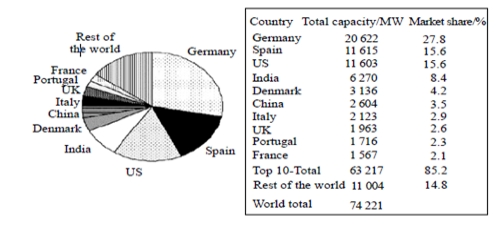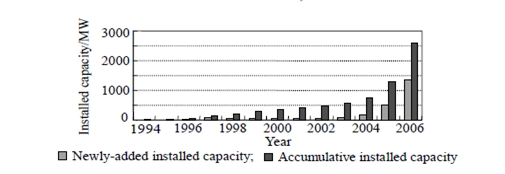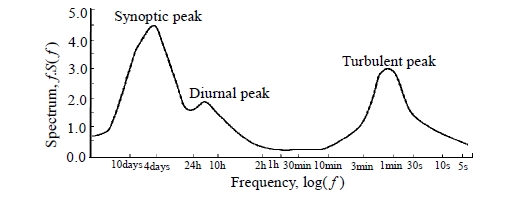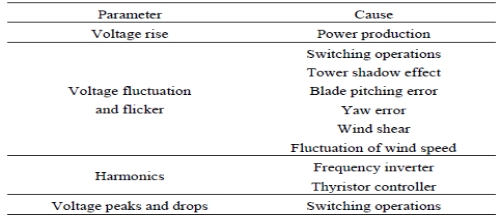Influence Research of Wind Power Generation on Power Systems
Jane Austen,Kurt Felix
(State Key Lab of Control and Simulation of Power Systems and Generation Equipments,Manhattan District,New York,United States)
Abstract: Wind power generation is always weather dependent and has the trend of being integrated to power systems as the form of large-scale wind farms, which influences on power systems. Since the power network was not designed specifically to accommodate this type of generation, there are inevitably some points at which modifications must be executed if existing standards of electricity supply are to be maintained. This paper discusses in general terms the problems which are encountered by the developers of wind power generation projects and by utility grids when dealing with projects to integrate wind farms to power systems. The influence includes active and reactive power flow, voltage, system stability, power quality, short-circuit capacity, system reserve, frequency and protection due to the characteristics of high-capacity, dynamic and stochastic performance of wind power generation. Corresponding countermeasures to handle these issues are recommended in order to accommodate wind power generation in power systems.
Key Words: wind power generation;power system;influence;wind farms
0.Introduction
There is widespread acceptance that renewable generation is the future of electricity supply. Generation based on fossil fuels is not sustainable as power electricity is being consumed rapidly. On the contrary, wind power has attracted much attention as a promising renewable energy resource. It has potential benefits in curbing emissions and reducing the consumption of irreplaceable fuel reserves when the demand for power electricity has been steadily growing due to the industrial developments and the growth of the economy in most parts of the world.
Wind power generation is becoming more and more popular while the large-scale wind farm(hundreds of megawatts) is the mainstream one. During 2006, the world’s installed wind capacity reached 74 223 MW, up from 59 091 MW in 2005,which include wind energy developments in more than 70 countries around the world. The tremendous growth in 2006 shows that decision makers are starting to take seriously the benefits that wind energy development can bring.
There are no technical, economic or resource barriers to supplying 12% of the world’s electricity needs with wind power alone by 2020, and this against the challenging backdrop of a projected two thirds increase of electricity demand by that date. The report is a crucial tool in the race to cut greenhouse gas emissions as 12% electricity from a total of 1 250 GW of wind power installed by 2020 will save a cumulative 10771 million tons of CO2[1].
Large-scale wind farms connected to power systems have characteristics of high capacity, dynamic and stochastic performance, which challenges system security and reliability. While providing the clean power for power systems, wind farms will also bring about some unfavorable influence on power systems. With the expansion of wind power generation and the increase of wind power ratio in a power system, the influence will likely become the technical barriers for wind power integration. Therefore, the influence should be discussed and the countermeasures to overcome these issues should be proposed.
According to the issues mentioned above, this paper discusses in general terms the problems which are encountered by the developers of wind power generation projects and by utility grids when dealing with projects to integrate wind farms to power systems. Due to the characteristics of high-capacity, dynamic and stochastic performance of wind power generation, the influence includes active and reactive power flow, voltage, system stability, power quality, short-circuit capacity, system reserve, frequency and protection. After that, corresponding countermeasures to handle these problems are recommended in order to accommodate wind power generation in power systems.
1.Development situation of wind power generation
From the report of the Global Wind Energy Council (GWEC), the countries with the highest total installed capacity are Germany (20 621 MW), Spain (11 615MW), the USA (11603MW), India(6270 MW) and Denmark (3 136 MW). Thirteen countries around the world can now be counted among those with over 1000 MW of wind capacity, with France and Canada reaching this threshold in 2006. Fig.1 shows the top 10 cumulative installed capacity of the world until December, 2006[2].
China started to develop wind power very late. It stepped into the stage of commercialized development and scale construction only in 1990s. Accumulated and newly added installed generating capacity over the years is shown in Fig.2.The single-unit capacity increased from 100 kW, 200 kW, and 300 kW to 600 kW, 750 kW, and 1500 kW step by step.

Fig. 1 Top 10 cumulative installed capacity of the world until December,2006

Fig. 2 Accumulative and newly-added installed capacity of wind power in China
China doubled more than its total installed capacity by installing 1 347 MW of wind energy in 2006, a 70% increase from last year’s figure. This brings China up to 2 604 MW of capacity, making it the sixth largest market world wide. the Chinese market has grown substantially in 2006, and this growth is expected to continue and speed up. According to the list of approved projects and those under construction, more than 1 500 MW will be installed in 2007. The goal for wind power in China by the end of 2010 is 5000 MW[3].
2.Characteristics of wind power generation
From the point of view of wind energy, the most striking characteristic of the wind resource is its variability. The stochastic variation of wind farms outputs root mainly in fluctuation of the wind speeds and directions. The wind is highly variable, both geographically and temporally. Furthermore this variability persists over a very wide range of scales, both in space and time.
The wind speed varies continuously as a function of time and height. The time scales of wind variations are presented in Fig.3 as a wind frequency spectrum[4]. The turbulent peak is caused by gusts in the sub second to minute range. The diurnal peak depends on daily wind speed variations and the synoptic peak depends on changing weather patterns, which typically vary daily to weekly but include also seasonal cycles.

Fig. 3 Wind spectrum farm Brookhaven based on work by van der Hoven
From a power system perspective, the turbulent peak may affect the power quality of wind power generation. The influence of turbulences on power quality depends very much on the turbine technology applied. Variable-speed wind turbines, for instance, may absorb short-term power variations by the immediate storage of energy in the rotating masses of wind turbine drive trains. That means that the power output is smoother than strongly grid-coupled turbines, fixed-speed wind turbines. Diurnal and synoptic peaks, however, may affect the long-term balancing of power system, in which wind speed forecasts plays a significant role.
Another important issue is the long-term variations of the wind resources. The wind speed up to the height of the hub should be known to calculate the wind farm output. A number of measurements of wind speeds show that wind speeds are mostly mild in a year; their probabilities between 0 and 25m/s are considerable; most of the average annual wind speeds subject to the Wei bull distribution[5], as in formula(1).

 (1)
(1)
where: v is average wind speed; k is shape parameter; c is scale parameter.
The relationship between the wind turbine output Pw and the wind speed up to the height of the hub v can be expressed approximately as the curve of wind turbine’s outputs vs. wind speed or a subsection function, as in formula (2).



 (2)
(2)
where: Pw is rated output of the wind turbine; v is wind speed up to the height of the hub; VCI is cut-in wind speed; VCO is cut-out wind speed; VR is rated wind speed.
3.Influence of wind power generation on power systems
High penetration of wind power in the power systems faces fundamental technical limits with regard to the integration of large-scale wind farms to the grid. The influence of wind power generation on power systems includes active and reactive power flow, voltage, system stability, power quality, short-circuit capacity, system reserve and infrastructure due to the characteristics of high-capacity, dynamic and stochastic performance of wind power generation. Technically, it influences the gird in the following ways and has to be studied in detail:
(1)Active and Reactive Power Flow.
Wind power is a kind of intermittent and stochastic power source, which will complicate the power flow. Because many wind farms are built far away from load centers in order to capture more wind energy, there is always some obstacle of transmitting wind power. Some transmission or distribution lines and other electrical equipments may be over-loaded when the additional wind power generation is introduced. So it should be ensured that the interconnecting transmission or distribution lines will not be over-loaded. Both active and reactive power requirements should be investigated. Reactive power should be generated not only at PCC, but also throughout the network, and should be compensated locally[6].
The methods utilized for analysis of conventional generators are certain and ignore the uncertainty of wind speed and load forecasts. Therefore, the probabilistic method is more suitable for wind power generation. This model is based on the wind speed distribution, such as formula (1). The constraints are described by probabilistic forms and the expected values of parameters, such as voltages and powers can be computed.
(2)Voltage Regulation.
Once a wind farm has identified its site, the point at which connection to the grid must be identified. Small wind farm can connect at lower voltage, thereby saving on switchgear, cable and transformer costs. If the size of the proposed development is too large to be connected at the local distribution voltage, access to the transmission network at a higher voltage is required[7].
After failures, if the transient unstability does not occur in power systems, some wind turbines shut down due to their low voltage protections. Then outputs of wind farms decrease, which means that the power system lose reactive loads. Therefore the voltage levels climb up, even beyond the upper limits of wind farms buses.
Capacitors are the common reactive power compensation methods. When voltage levels dropdown, the amount of compensation decreases much. However the reactive power demands increase when the asynchronous machines are utilized in wind farms. So voltage levels drop down more, even beyond the lower limits of wind farms buses.
With the increase of wind power installed capacity in power systems, the variability of wind power generation causes variability of voltage level, particularly if integrated into the grid which might not be specifically designed to cater for the significant and possibly rapid load variations (compared with normal customer load variation) caused by highly variable wind power generation. Therefore, the regulatory measures are needed to maintain the voltage level in a specified range. However, the variability of wind power generation is not a low probability; this could result in an increased requirement for reactive power ancillary services to manage voltage control[8].
(3)System Stability.
In the power system with high wind power penetration, the transient stability, voltage stability and frequency stability are all influenced by the wind power integration not only because the injection of wind power will change the power flow distribution, transferred power of each transmission line and total inertia of the whole power system, but also because the wind turbine generators perform differently in either steady-state or transient-state compared with the conventional synchronous machine[9].
For current operation of wind farms, protections usually cut off the connections between wind farms and the grid when great disturbances occur. This is equivalent to arouse new generators tripping disturbance after the great disturbances. So the transient stability in such moment is very crucial, especially when large-scale wind farms are integrated. Compared the variable-speed wind turbine based on the doubly-fed induction generator (DFIG) with the fixed-speed wind turbine based on the induction motor, the former is more robust after short-circuit failures and can strengthen system stability with keeping enough stability margin. However, wind power integration may also make the system transient stability worse due to the grid structure. Therefore, transient stabilities of different power systems should be analyzed respectively.
The fixed-speed wind turbine absorbs the reactive power when outputting the active power. The whole demand of a wind farm for the reactive power is considerable, which lead to the decrease of the voltage stability in the area near PCC. On the contrary, the variable-speed wind turbine based on DFIG has certain ability to control the reactive power. According to different operation and control schemes, this wind turbine can absorb or output the reactive power to control the voltage, which benefits the voltage stability. The voltage stability is also related with the short-circuit capacity of PCC, transmission line ratios of R/X and reactive compensation methods utilized of wind farms.
(4)Power Quality.
Fluctuations in the wind power and the associated power transport (AC or DC), have direct consequences to the power supply quality. As a result, large voltage fluctuations may result in voltage variations outside the regulation limits, as well as violations on flicker and other power quality standards. During the continuous operation and switching operation, wind turbine causes voltage fluctuation and flicker, which are main concerns of unfavorable influence of wind power generation on power quality of the grid. For wind turbine of variable-speed and constant-frequency, harmonic issue caused by converters should also be considered.
The grid interferences of wind turbines or wind farms have different causes, which are mostly turbine-specific. The relevant parameters are listed in Tab.1[10]. Average power production, turbulence intensity and wind shear refer to causes that are determined by meteorological and geographical conditions. All the other causes are attributed not only by the characteristics of the electrical components, such as generators, transformers and so on, but also by the aerodynamic and mechanical behavior of the rotor and drive train. The turbine type (i.e. variable versus fixed speed stall versus pitch-regulated) is of major importance to the power quality characteristics of wind turbines and wind farms.
Tab. 1 Crid interferences caused by wind turbines and wind farms

Flicker is caused by the fluctuation of active and/or reactive power of wind turbines. The main reason for flicker in fixed-speed wind turbines is the wake of the tower while for variable-speed wind turbines, fast power fluctuations are smoothed and the wake of the tower does not affect power output. Therefore, the flicker of variable-speed wind turbines is in general lower than the flicker of fixed-speed wind turbines. In wind farms, power fluctuations are smoothed because of the fact wind turbines are correlated.
(5)Short-Circuit Capacity.
The majority of the wind power farms tend to be constructed remote from the load center, which means that electrical distance between them and the other part of the power system is rather long. There is a common sense that long electrical distance makes voltage variation bigger but short circuit problem smaller[11].
However, wind power farms will be able to give more and more significant effects on the calculation of short circuit current in future power system operation. The reason is twofold. One is the above stated fact that wind power generation site is usually apart from the conventional electrical power center. It implies that the distribution of short circuit current might make a drastic change, leading to a completely different short circuit capacity map. The other reason is the fact that more and more wind power generation today are particularly in the form of so called large-scale wind farms (hundreds of megawatts). In wind farms a substantial number of individual units are connected together, and the total generation capacity will greatly rise up.
Wind farms have great influence on the short circuit capacities of adjacent nodes while the nodes far apart from PCC are little influenced[9]. Therefore, when wind farms with huge capacities are integrated into the grid, capacities of adjacent transformers and switches may need to be increased. It should be studied further how to determine the influence of wind power generation on the short circuit current ratings of existing electrical equipments on the network.
(6)System Reserve.
Meanwhile, system load forecast will potentially become less accurate as the amount of wind power generation increases, which in turn influence power system operational scheme and unit commitment. In the case of generation reserve forecasts, this could translate into higher reserve level requirements to cover uncertainties in the availability of wind power generation[8].
(7)Frequency Regulation.
In order to control power system frequency within defined standards, grid corporations require some power plants to provide frequency control ancillary services. However, as the total amount of wind power generation increases, variation in its output will have a more significant impact on the frequency[8].
(8)Protection.
As for any proposed expansion of a utility grid, there are problems to be addressed with each application for connection. For connection to the distribution system, the proposed generation must have a relatively low capacity. In general, that part of the network is radial and the protection would be graded to expect fault current to flow outwards from the hulk supply point. Introduction of a generator into the radial network means that fault current can now be supplied which does not flow in the expected direction. A detailed check of the protection settings with the proposed generator in the network model is therefore required. The results of this check may show that the protection will function quite adequately as it is. At the other extreme, it may show that the existing relays cannot protect the network while the new generation and a redesign of the protection is necessary[7].
The power flows between wind farms and the grid are bidirectional, which should be considered during the protections design and configuration. Whatever kind of generators are adopted in wind turbines, integration of a wind farm will increase the fault level of grid and furthermore affect the relay settings of original protection devices of grid. It is probably necessary to add new protection devices and/or modify the relay settings of original protection devices. Particularly if wind farms are connected into distribution networks, overloading of circuit breakers may occur with the increase of installed capacity of wind farm[8].
4.Countermeasures to mitigate wind power generation influence
The applications of the reactive compensation equipments, such as static var compensator (SVC) and static synchronous compensator (STATCOM) play an important role in wind power generation to mitigate its influence on the power system. In order to maintain the voltage level, the grid corporation may provide additional or upgraded voltage control facilities. Reactive compensation equipments should be installed in the step-up substation of wind farm, which has a fast response characteristic and can be regulated continuously, such as SVC and STATCOM, etc. In order to mitigate voltage fluctuation and flicker caused by wind power generation, both speed control and pitch angle control should be improved so as to minimize the fluctuation of wind turbine output while maximizing the output of wind turbine. Meanwhile, installation of auxiliary devices on wind farm such as SVC and energy storage device can also mitigate both voltage fluctuation and flicker. In most cases, fast-acting reactive-power compensation equipment, including SVC and STATCOM, should be included for improving the transient stability of the network.
From the wind power generation side, it can improve the voltage stability of the power system and increase wind power penetration by the constant power factor control or constant voltage control. From the grid side, it is of significance to reinforce and change the current network. Voltage source converter (VSC) based HVDC (VSC-HVDC) is a transmission system that does not require any additional compensation, as this is inherent in the control of the converters[13]. It will therefore be an excellent tool for bringing wind power into a network, even at weak points in a network and without having to improve the short-circuit ratio. The active power control capability of VSC-HVDC could then be a perfect tool for handling active power/frequency control. It is capable of handling wind power and of reacting rapidly enough to counteract voltage variations in an excellent way, which can improve the system stability and power quality.
5.Conclusion
Wind energy has come a long way since the prototypes of just 25 years ago, and it will probably continue to advance over the next twenty years. There are a number of issues associated with integration of wind power in system operation and development. Although penetration of wind power generation may displace significant amount of energy produced by conventional plants, concerns are focused on the interaction between wind power generation and the grid. This paper has provided an overview of the influence of wind power generation on power systems and recommended corresponding countermeasures to handle these issues in order to accommodate wind power generation in power systems.
Reference
[1] EWEA.Wind force 12[EB/OL].
[2] GWEC.Global wind energy markets continue to boom-2006 another record year[EB/OL]
[3] Liu Yan,Wang Wei wind power information Technology.2007
[4] Burton T,Sharpe D,Jenkins N,et al.Wind energy handbook[M].Chichester:John Wiley & Sons Ltd,2001
[5] Bowden G J,Barker P R,Shestopal V O,et al.Weibull distribution function[J].Wind Engineering,1983,7(2):85-98
[6] Fan Zhenyu,Enslin J H R.Challenges, principles and issues relating to the development of wind power in China[C].IEEE PES PSCE,2006:748-754
[7] O'Gorman R,Redfern M A.The difficulties of connecting renewable generation into utility networks[C].IEEE Power Engineering Society General Meeting,2003,3:1466-1471
[8] Wang Wei sheng,Chen Mozi.Towards the integrating wind power into power grid in China[J].Electricity,2004,(4):49-53
[9] Chi Yong ning,Liu Yan hua,Wang Wei sheng,et al.Study on impact of wind power integration on power system[J].Power System Technology,2007,31(3):77-81
[10] Ackermann T.Wind power in power systems[M].Chichester:John Wiley & Sons Ltd,2005
[11] Kumano T.A short circuit study of a wind farm considering mechanical torque fluctuation[C].IEEE Power Engineering Society General Meeting,2006:1-6
[12] Strbac G,Shakoor A,Black M,et al.Impact of wind generation on the operation and development of the UK electricity systems[J].Electric Power Systems Research,2007,77(9):1214-1227
[13] Eriksson K,Liljegren C,Sobrink K.HVDC light experience sapplicable for power transmission from offshore wind power parks[EB/OL].



